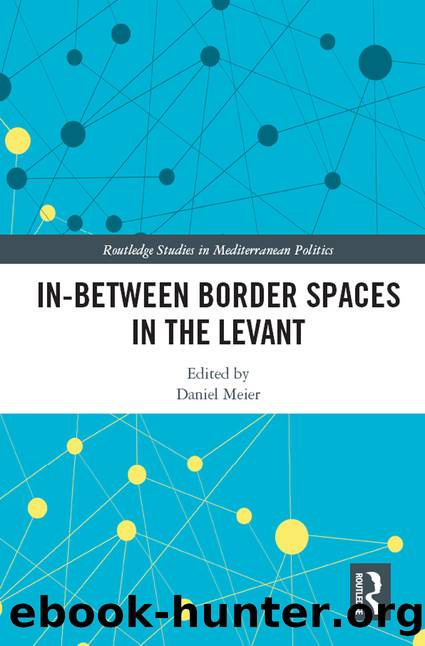In-Between Border Spaces in the Levant by Daniel Meier

Author:Daniel Meier [Meier, Daniel]
Language: eng
Format: epub
ISBN: 9780367632359
Google: MX2pzQEACAAJ
Goodreads: 54613976
Publisher: Routledge
Published: 2020-11-30T00:00:00+00:00
Notes
1. The main reference here is to the work of Antonio Gramsci and especially his concept of hegemony, particularly as it was developed in âLa questione meridionaleâ (2005) and his âQuaderni dal carcereâ (2014).
2. Maronitism is the political and socio-economic strategy promoted by the Maronite community and is characterized by the imposition of a pervasive political presence, conservatism and an economic policy of laissez-faire. See Hagopian (1989).
3. These courts vary from community to community but have the common characteristic of enjoying great autonomy that, de facto, escapes control of the stateâs judiciary bodies. The Lebanese Court of Cassation, Lebanonâs highest court, is the final arbiter of disputes and is responsible for examining the compatibility of religious codes with the public order. However, it has long interpreted this responsibility as being limited to examining jurisdictional and procedural rather than substantive religious rules.
4. Of course, there is a significant risk that the concept of liminality becomes overstretched. For example, when we move from individuals and groups to the entire society or to the international system, the danger is determinism, namely that liminality can be found in every place and experience across time and space.
5. The National Pact was an (unwritten) agreement that legitimized the power of the Maronite and Sunni communities at not only the social but also the state level. The National Pact outlined a power system based on representativeness (also in demographic terms) of the communities, which favoured the Christians. See, among others, Assaf (1999) and Zamir (1985).
6. The last regular census in Lebanon was carried out in 1932; since then, the demographic question has been used instrumentally by all the political parties in the country.
7. In âChristianâ surveys, the comparison is between Muslims and Christians as a whole and not between communities because this would further underline the Maronitesâ marginalization. Today, Christians make up about 34 per cent of the Lebanese population. Lebanese Information Centre (2013).
8. Interview, member of the Lebanese Forces, Maarab, 22 November 2014.
9. The main points in the agreement echoed the 1943 National Pact, except for a new power-sharing arrangement between communities, which introduced a new political and institutional setup. The countryâs (Maronite) president was replaced by the (Sunni) prime minister as the highest political authority in Lebanon; the powers and term of office of the (Shiite) president of Parliament were increased, and the number of deputies was increased to 128, equally shared between Christians and Muslims.
10. This is not new as intra-Maronite competition has always existed.
11. Interview, political journalist, Beirut, 21 November 2014; interview, Lebanese parliamentary, Beirut, 19 November 2014.
12. One of the most interesting pieces of evidence is the creation, in May 2003, of the Qornet Shehwan Gathering coalition. Its aim was to increase Christian participation in the elections in response to the negative effects of the amended electoral law, which they had strongly opposed. The gathering took on a more official tone only after the first Council of Bishopsâ statement and consolidated itself as the political wing of the patriarch.
13. After the 2009
Download
This site does not store any files on its server. We only index and link to content provided by other sites. Please contact the content providers to delete copyright contents if any and email us, we'll remove relevant links or contents immediately.
Man-made Catastrophes and Risk Information Concealment by Dmitry Chernov & Didier Sornette(5955)
The Revenge of Geography: What the Map Tells Us About Coming Conflicts and the Battle Against Fate by Kaplan Robert D(4052)
Zero Waste Home by Bea Johnson(3804)
COSMOS by Carl Sagan(3588)
Good by S. Walden(3518)
In a Sunburned Country by Bill Bryson(3506)
The Fate of Rome: Climate, Disease, and the End of an Empire (The Princeton History of the Ancient World) by Kyle Harper(3030)
A Wilder Time by William E. Glassley(2833)
Camino Island by John Grisham(2778)
Organic Mushroom Farming and Mycoremediation by Tradd Cotter(2661)
The Ogre by Doug Scott(2657)
Human Dynamics Research in Smart and Connected Communities by Shih-Lung Shaw & Daniel Sui(2479)
Energy Myths and Realities by Vaclav Smil(2463)
The Traveler's Gift by Andy Andrews(2435)
9781803241661-PYTHON FOR ARCGIS PRO by Unknown(2342)
Inside the Middle East by Avi Melamed(2325)
Birds of New Guinea by Pratt Thane K.; Beehler Bruce M.; Anderton John C(2236)
A History of Warfare by John Keegan(2212)
And the Band Played On by Randy Shilts(2165)
